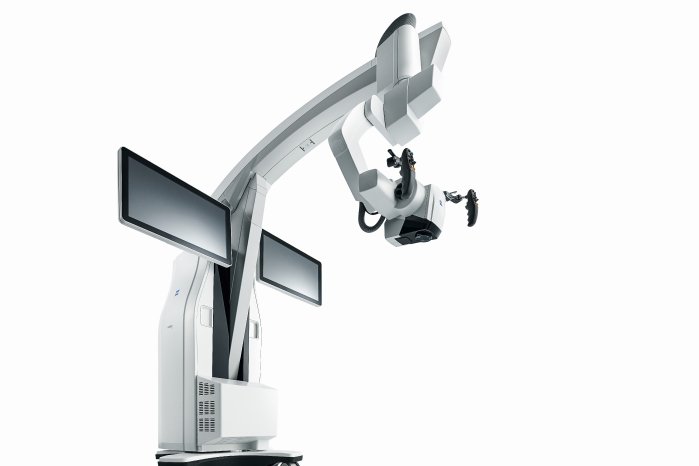Neurosurgeons want to focus on surgery and have comprehensive information exactly when they need it. "When we decided that the all-new visualization system would be robotic, our vision was to be able to much better assist the surgeons. In addition, we addressed their request to look around the corner and work heads-up, while still having the freedom of choice to use the optical view for parts of the surgery, where this may be preferable," says Dr. Ludwin Monz, President and CEO of Carl ZEISS Meditec AG.
Reducing manual effort
Surgeon-Controlled Robotics allow KINEVO® 900 to assist the surgeons better while making their workflow easier and more efficient using PointLock. Neurosurgeons are able to focus and move around a structure to visualize the targeted anatomy – reducing manual effort. In addition, PointLock enables them to do a KeyHole movement to observe a larger area inside a cavity – a particular benefit in areas with narrow access.
When working on a tumor case, neurosurgeons may need to return to identified regions of concern where they have to protect the functional structure. After storing these Bookmarks in PositionMemory, they can recall and return to the stored location at the exact same magnification, working distance and focus – without losing time for manual repositioning.
Expanding the line of sight
When working from the external perspective of a surgical microscope, visualization of the anatomy is limited to a straight line of sight – potentially missing critical information behind tissue or corners. QEVO®1, the unique, proprietary Micro-Inspection Tool complements intraoperative microsurgical visualization, enabling neurosurgeons to discover unexplored areas during the surgical intervention without additional footprint. They can look around corners and eliminate blind spots, gaining greater insights – for better clinical decisions.
"I was fortunate enough to have the ability to use the QEVO addition to the microscope which I find really provides that final solution of being able to see around corners. It visualizes the area we are interested in, that we can’t see through the microscope. Because QEVO can be seen as it’s inserted into the operative field while still having the microscope view it adds a degree of safety that we have not had," states Dr. Robert F. Spetzler, Barrow Neurological Institute, Phoenix, USA.
To support the surgical workflow, QEVO is engineered with an angled design supporting safer insertion and keeping the hands out of the line of sight. This also makes it fit easily between KINEVO 900 and the situs, eliminating the need to reposition the microscope.
In the development of the Micro-Inspection Tool, ZEISS placed a high priority on its ease of use: QEVO is truly integrated and available without planning – as it is fully autoclavable and there is no need for additional draping.
Enabling ocular-free surgery
Working through oculars at extreme angles can sometimes be cumbersome. Neurosurgeons may have to accept uncomfortable working positions, hence causing fatigue. Digital Hybrid Visualization with the integrated 4K technology of ZEISS KINEVO 900 introduces heads-up, ocular-free surgery, giving the neurosurgeon freedom of movement. And, freedom of choice to use an optical setup, depending on the application need.
Assistant surgeons, OR staff and residents also benefit from the 4K visual clarity of KINEVO 900. They share the same high-resolution, digital image allowing them to follow the procedure with comparable fidelity, delivering indispensable education and training.
"Together with leading neurosurgeons we developed and integrated scores of cutting-edge innovations into ZEISS KINEVO 900," says Dirk L. Brunner, Senior Vice President, Microsurgery Division, Medical Technology Business Group, "all with the goal of providing neurosurgeons with innovations that support them in their clinical decisions. We are convinced that our new Robotic Visualization SystemTM will help move the field to a new level."
Reference:
1 Not for sale in the USA. 510(k) is pending. Not available in all markets.


